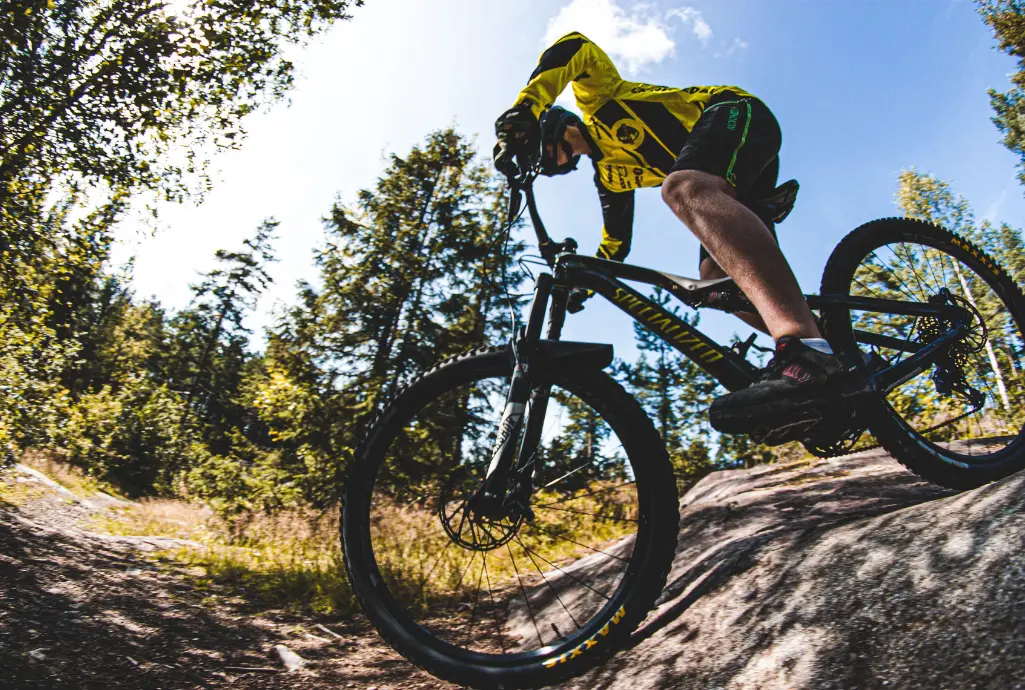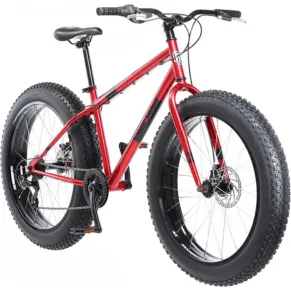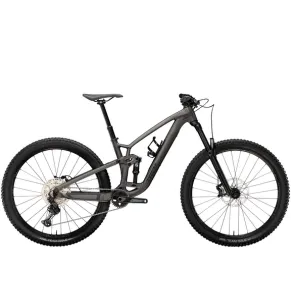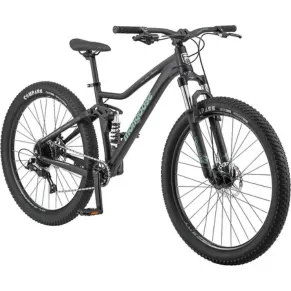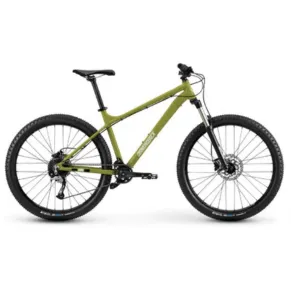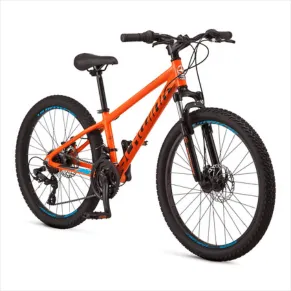As a bike enthusiast professional, we understand the concerns of being a bigger guy looking to get into mountain biking. Finding the right bike that is comfortable, durable and capable of withstanding additional weight can be daunting. But fear not! There are plenty of great options out there designed with you in mind. Here are our top 10 best mountain bikes for bigger guys. In case you’re considering wider selection of bikes, read our article about best bikes for bigger guys as well.
Table of Contents
Mongoose Dolomite Fat Tire Mens Mountain Bike for Bigger Guys
The Mongoose Dolomite Fat Tire Mountain Bike is a strong contender for any big guy looking to hit the trails. This bike beast boasts a sturdy steel frame material, 7-speed Shimano drivetrain, and extra-large 4-inch-wide knobby fat tire bikes. With a design that provides superior balance and traction, it’s crafted to handle the challenges of off-road biking while catering to big and tall riders.
Pros
Heavy-Duty Frame: Built with a high-tensile steel frame, the Mongoose Dolomite can handle extra weight, providing a durable foundation for your rides.
Fat Tires: The extra-wide 4″ tires offer excellent balance and stability. They distribute your weight evenly, reducing the risk of tire punctures and providing superb grip on various terrains.
7-Speed Drivetrain: The Shimano 7-speed drivetrain allows you to handle various trail conditions. Whether powering up hills or cruising along flat paths, you’ll always have the right gear.
Comfort: With a cruiser-style saddle and wide handlebars, this bike emphasizes comfort, even on longer rides. Maintaining an upright position is easier, reducing strain on your back and arms.
Cons
Weight: The strength of the Dolomite comes with a trade-off – it’s heavier than many other mountain bikes. The extra weight can make it more challenging to transport and maneuver, especially uphill.
Assembly: The Dolomite is shipped partially assembled, and completing the assembly can be tricky, especially for novice riders. You might need professional help to get it ready to roll.
Lack of Suspension: This bike does not feature a suspension system, which could make rides on bumpy terrain less comfortable.
Maintenance: The fat tires and steel frame require regular maintenance to keep the bike in top condition. You’ll need to regularly check and adjust the tire pressure to ensure optimal performance.
Key features
The Mongoose Dolomite Fat Tire Mountain Bike is a worthy choice for big and tall guys exploring mountain biking. The heavy-duty mountain bike frame and extra-wide fat tires make it a robust option capable of handling additional weight. It provides excellent balance and stability, key factors for heavier riders. However, it’s important to consider the bike’s weight, lack of suspension, and potential maintenance needs.
While it may not be the lightest or most agile bike on the market, its sturdiness, comfort, and durability are key features that make it a strong contender for the heavy big guys out there. Essentially, it’s a well-rounded bike that doesn’t shy away from the extra pounds but embraces and supports them for an enjoyable ride.
Schwinn Bonafide Mens Mountain Bike
2. Best Mountain Bike for Bigger Guys
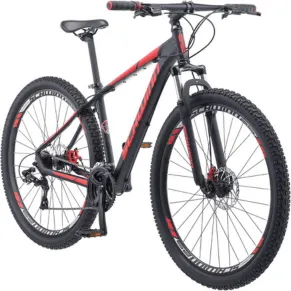
Schwinn Bonafide Mens Mountain Bike
The Schwinn Bonafide stands out with its heavy-duty construction and performance-driven design for those big guys seeking a reliable and robust heavy duty mountain bike. This bike is equipped with a strong aluminum mountain frame, 24-speed Shimano EZ-Fire trigger shifters, and a front and rear mechanical disc braking system, so it is ready to tackle any terrain you throw at it.
Pros
Durable Frame: The Schwinn Bonafide features a strong aluminum frame designed to handle extra weight, offering both durability and a relatively lighter weight than steel frames.
24-Speed Drivetrain: The Shimano EZ-Fire trigger shifters provide a 24-speed drivetrain, offering a wide gear range. This allows you to handle various trail conditions, from steep climbs to fast descents.
Rear Disc Brakes: Front and rear mechanical disc brakes offer superior stopping power, a critical safety feature, especially for heavier riders.
High-Profile Rims: The bike comes with high-quality double-wall alloy rims that are durable and lightweight, adding to the bike’s strength and stability.
Cons
Saddle Comfort: While the bike boasts many excellent features, the saddle might be less comfortable for bigger riders during longer rides. An upgrade might be necessary for added comfort.
Assembly: Similar to the Mongoose Dolomite, the Schwinn Bonafide is shipped partially assembled, which might be challenging for some, especially first-time bikers.
Tire Durability: While the tires are well-made, they might need frequent pressure checks and potential replacements sooner than expected, especially when riding on rough terrains.
No Suspension Lockout: Although the bike has a front suspension, it lacks a lockout feature. This can make uphill climbs or riding on flat surfaces more challenging as some energy can be lost to the suspension movement.
Key features
The Schwinn Bonafide Mens Mountain Bike is a commendable option for bigger guys, offering a sturdy aluminum frame and powerful disc brakes. The 24-speed drivetrain ensures you’re prepared for varying trail conditions. Although it might need adjustments, like a possible saddle upgrade and regular tire pressure checks, the bike’s durability and versatility make it a worthwhile choice. This bike balances comfort, performance, and durability, making it a solid choice for larger riders looking to take on the mountain trails. It demonstrates that being a bigger guy doesn’t limit your possibilities in mountain biking – it’s all about finding the right gear to support you on your adventures.
Trek Fuel EX 7
The Trek Fuel EX 7 stands out in mountain bikes, offering strength, versatility, and advanced features. With its solid frame, full-suspension setup, and reliable performance, this bike is designed to handle the rigors of off-road cycling while catering to riders of all sizes, including those on the larger side.
Pros
Solid Frame: The Trek Fuel EX 7 is built with an Alpha Platinum Aluminum frame, which is durable and lightweight. It is designed to handle additional weight without compromising on performance.
Full Suspension: The bike features a full-suspension setup, which can handle impacts better and provide a smoother ride on bumpy terrains. This benefits heavier riders, as it reduces strain and improves comfort.
Versatility: With a 1×12 drivetrain, this bike offers a wide range of gears to handle various trail conditions, making it a highly versatile choice for bigger riders.
Hydraulic Disc Brakes: This bike is equipped with powerful hydraulic disc brakes, which provide reliable stopping power, crucial for safe riding, particularly for heavier riders.
Cons
Price: The Trek Fuel EX 7 is on the pricier end of the spectrum. While it offers many advanced features, it might only fit some budgets.
Weight: Despite its aluminum frame, this bike is still heavier than some other models, which could make it more challenging to handle, especially for novice riders.
Tire Durability: Similar to other mountain bikes, the tires may require frequent checks and maintenance, particularly if used on harsh terrains often.
Seat Comfort: As with many standard mountain bikes, the seat might not offer the best comfort for bigger guys on longer rides. A seat upgrade may be necessary for added comfort.
Key features
The Trek Fuel EX 7 is an excellent choice for bigger guys serious about mountain biking. Its sturdy frame and full-suspension setup make it a reliable option that comfortably accommodates heavier riders. Thanks to its wide range of gears and the superior stopping power the hydraulic disc brakes offer, the bike’s versatility is a significant asset. While the cost and weight may be considerations, the performance and durability of this bike are impressive.
It might require a bit of customization, like a new seat for enhanced comfort. Still, the Trek Fuel EX 7 demonstrates that even larger riders can enjoy the thrills of mountain biking with the right equipment. Your size should not limit your adventures but inspire you to find the perfect gear to support them. The Trek Fuel EX 7 could be just that gear.
Mongoose Impasse Mens Mountain Bike for Big Men
The Mongoose Impasse Mountain Bike is another fantastic option for big men, offering a powerful yet comfortable ride experience. This sturdy bike comes with a robust aluminum frame, 21-speed shifters, and dual suspension, making it a reliable choice for those larger riders keen on tackling a variety of terrains.
Pros
Strong Frame: The Mongoose Impasse features a robust aluminum frame that can comfortably bear extra weight, providing a sturdy foundation for your rides.
21-Speed Shifters: The bike’s 21-speed shifters give you plenty of gear options to handle diverse trail conditions, making it versatile for different types of terrain.
Dual Suspension: The bike’s dual suspension system ensures a smoother ride on bumpy trails, a key comfort feature for heavier riders.
Alloy Wheels: The 29″ alloy wheels add to the overall strength and stability of the bike, offering a smooth, stable ride for larger riders.
Cons
Weight: Despite its aluminum frame, the bike is still heavier than some competitors, making handling and transportation more challenging.
Assembly: Like many bikes, the Mongoose Impasse requires assembly upon delivery, which can be complex for those without prior experience.
Brakes: The bike comes equipped with rear and front disc brakes, which offer good stopping power but might require frequent adjustments and maintenance.
Seat Comfort: The stock seat might not be as comfortable for larger riders during prolonged rides, and an upgrade could be necessary for better comfort.
Key features
The Mongoose Impasse Mens Mountain Bike is a compelling option for big guys. It offers a robust structure, versatile gear options, and a dual suspension system for comfortable riding on challenging terrains. While the bike’s weight and the potential need for a seat upgrade might be worth considering, its strong frame and alloy wheels make it a trustworthy choice to handle extra weight. It requires tuning and customizing to fit individual needs. Still, the Mongoose Impasse demonstrates that size doesn’t have to limit one’s mountain biking adventure. It’s all about getting the right bike that supports and enhances your ride, and this bike can very well be the one for bigger riders.
Diamondback Line
The Diamondback Line is a versatile and robust mountain bike that checks all the boxes for big guys into trail riding. Built with an aluminum alloy frame, a 1×12 speed drivetrain, and hydraulic disc brakes, this bike brings together strength, reliability, and high-performance features.
Pros
Aluminum Alloy Frame: The Diamondback Line is constructed with a strong, lightweight aluminum alloy frame designed to accommodate extra weight without compromising stability or performance.
1×12 Speed Drivetrain: The bike’s 1×12 speed drivetrain offers a wide range of gears that can handle different terrains, enhancing the riding experience for bigger riders.
Hydraulic Disc Brakes: This bike features hydraulic disc brakes, providing excellent stopping power, a key safety factor, particularly for heavier riders.
Full Suspension: The Level Link full suspension mountain bike design offers excellent traction and control on uneven terrains, providing a smoother ride, which can be particularly beneficial for heavier riders.
Cons
Price: The Diamondback Line is a higher-end model and might be a significant investment. The price tag might be a consideration for some riders.
Weight: While its aluminum frame keeps it lighter than some steel models, it still carries some weight, which might affect its maneuverability, especially for beginners.
Assembly: The bike comes partially assembled, which can be challenging for those unfamiliar with bike assembly. You may need professional help or be ready for DIY work.
Seat Comfort: The stock seat might need optimal comfort for bigger guys during long rides. Consider a seat upgrade for better comfort.
Key features
The Diamondback Line is a high-performance, durable, and versatile mountain bike for larger guys. Its solid frame, wide gear range, excellent braking system, and full suspension mountain bikes design make it a highly capable option for off-road cycling. While it’s a more significant investment than other models, and the weight and assembly may pose some challenges, its quality and performance make it a worthy choice. It demonstrates that even bigger riders can enjoy the thrills and challenges of mountain biking with the right bike. While the bike might need adjustments, such as a new seat for increased comfort, the The Diamondback Line can be your faithful companion on the trails, supporting your adventurous pursuits.
Schwinn High Timber Mountain Bike
The Schwinn High Timber Mountain Bike is another solid contender for bigger guys seeking a comfortable, reliable, and robust bike. It’s a versatile ride with a steel mountain frame, 21-speed twist gear shifters, and a front suspension fork, offering stability and a smooth ride on various terrains.
Pros
Durable Steel Frame: The Schwinn High Timber has a steel mountain frame that provides remarkable durability and can comfortably support extra weight.
21-Speed Shifters: With its 21-speed twist shifters, this bike offers a wide gear range to handle different trail conditions, making it an adaptable choice for larger riders.
Front Suspension: The bike’s front suspension fork helps to absorb bumps and shocks, offering a smoother ride, which is particularly important for heavier riders.
Strong Wheels: The bike has durable alloy wheels and larger knobby mountain tires designed for stability and durability on different trails.
Cons
Weight: Given its steel frame, this bike is heavier than its aluminum counterparts, which impacts handling and makes transportation challenging.
Brakes: While the bike features front and rear alloy linear pull brakes, these may provide less stopping power than disc brakes, which could concern bigger riders.
Assembly: As with many bikes, the Schwinn High Timber requires assembly upon arrival. For those without prior experience, this could be a little complicated.
Seat Comfort: The standard saddle may not provide enough comfort for bigger guys, especially during longer rides, and an upgrade might be needed.
Key features
The Schwinn High Timber Mountain Bike is a great choice for bigger guys looking for a sturdy and dependable mountain bike. Its steel frame and strong wheels offer a stable foundation, and the wide range of gears ensures versatility on various terrains. Although the bike’s weight and the potential need for a more comfortable seat may be considerations, its strength and resilience make it a worthy contender in mountain biking.
With some adjustments, like potentially upgrading the brakes and seat, the Schwinn High Timber proves that size doesn’t have to be a limiting factor in mountain biking. It’s all about choosing a bike that fits your needs and enhances your riding experience. This bike could be a solid fit for larger riders ready to embrace the thrill of off-road trails.

Buying Guide: The Ultimate Guide to Choosing the Best Mountain Bike for Bigger Guys
Now that you’ve got an idea of some great models to consider let’s delve into some key factors you should consider while making your selection:
Weight Limit
The weight limit of the bike is crucial. Most bikes will indicate their maximum weight capacity, typically between 220 to 300 lbs (100 to 136 kg) for mountain bikes.
Frame
The frame is, without a doubt, the most crucial component of your bike. It’s what holds everything together, and its quality and strength directly impact your bike’s overall durability and performance. Particularly for larger riders, a robust frame is non-negotiable.
There are primarily three materials used in bike frames – steel, aluminum, and carbon fiber. Each comes with its strengths and weaknesses:
- Steel: Known for its strength, steel frames can support more weight than other materials, making it a popular choice for larger riders. It’s also more flexible, absorbing some road vibrations, which provides a smoother, more comfortable ride. However, the downside of steel is its weight. Steel bikes tend to be heavier, which could make them harder to maneuver, especially uphill.
- Aluminum: This is the most commonly used material in bike frames today. Aluminum is lighter than steel and still provides a reasonable amount of strength, making it capable of supporting larger riders. The material is also corrosion-resistant, adding to the longevity of the bike. Aluminum frames, however, are stiffer, translating into a harsher ride, as they transfer more road vibrations directly to the rider. To mitigate this, some manufacturers use butted tubes (whose wall thickness varies) to improve ride comfort.
- Carbon Fiber: This material is usually found on high-end, performance-oriented bikes. Carbon fiber frames are light and stiff, providing an optimal power transfer, which results in a responsive and fast bike. These frames can also be molded into aerodynamic shapes for increased efficiency. However, there may be better choices for larger riders. Carbon fiber’s strength is highly dependent on the quality of the construction, and poorly made carbon frames can be less durable and susceptible to damage. They are also more expensive to manufacture, leading to a higher price tag on carbon fiber bikes.
For larger riders, a steel or aluminum frame is generally more suitable. The decision between these two may come down to a trade-off between steel’s strength and comfort and aluminum’s lightness and affordability. Personal preferences, the riding you intend to do (off-road vs. on-road), and your budget can also play a role in this decision. The most important thing is to ensure that the frame you choose can safely and comfortably support your weight, providing you with many happy hours of cycling.
Tires
Tires are crucial to your bike’s performance, comfort, and safety. They connect you to the ground, influence your speed, and absorb much shock from the road. For larger riders, choosing the right tire becomes even more important.
Wide tires are often the go-to choice for bigger riders for several reasons:
- Weight Distribution: Wide tires spread your weight over a larger surface area, reducing the pressure exerted on any single point. This helps prevent tire punctures and reduces the wear and tear on your wheels.
- Stability: A wider tire means a larger contact patch (the area of the tire touching the ground), which improves your bike’s stability and balance. This is particularly useful for larger riders, who may require extra stability.
- Traction: Wide tires typically offer better traction on various surfaces, from asphalt to gravel to dirt trails. This increased grip can boost your riding confidence, particularly on slippery or loose surfaces.
While wide tires offer these advantages, they come with a trade-off in rolling resistance, meaning they may require slightly more effort to pedal at the same speed as narrower tires. However, the benefits of improved weight distribution, stability, and traction for larger riders generally outweigh this minor downside.
In conclusion, consider a wider option when selecting a bike or upgrading your tires. It will enhance your riding experience and add an extra layer of safety and durability to your biking adventures.
Suspension
A bike’s suspension system significantly affects the rider’s comfort, control, and overall riding experience. It is designed to absorb shocks from bumps and uneven surfaces, leading to a smoother ride.
- Comfort and Control: You naturally exert more force on the bike when you’re a heavier rider. A good suspension system helps absorb this force, reducing the strain on the rider and the bike. This leads to increased comfort during rides and improved control over rough terrains, which is crucial for safety.
- Full vs. Hardtail Suspension: Mountain bikes for heavy riders often come in two types – full suspension and hardtail mountain bike (front suspension only). For larger riders, full-suspension bikes are generally more suitable. This is because they absorb impact from the front and the rear, effectively dealing with the additional weight and offering a smoother ride. Full-suspension bikes also provide better traction and control, enhancing the riding experience for bigger cyclists.
- Reduced Fatigue: A good suspension system reduces the shock that reaches the rider, leading to less fatigue during longer rides. This can be particularly beneficial for larger riders who might experience more strain on their joints.
While full-suspension bikes provide these advantages, they tend to be more expensive than hardtail bikes, and their maintenance can be slightly more complex due to the additional rear suspension components. However, the improved comfort, control, and reduced fatigue make them a worthy investment for larger riders.
In conclusion, prioritizing a bike with a high-quality suspension system, preferably full suspension, can significantly enhance the biking experience for heavier riders. It provides comfort on rough terrains, allows for better bike control, and aids in reducing rider fatigue on longer trails, making every ride a more enjoyable adventure.
Saddle
The saddle is a critical component for comfort during cycling. Choosing the right saddle is even more important for larger riders as it supports a significant amount of their weight and can greatly affect the overall riding experience.
- Size and Shape: Larger riders generally benefit from a wider saddle. This is because a wider saddle provides more surface area for weight distribution, reducing pressure points and making the ride more comfortable.
- Padding: A well-cushioned saddle can significantly increase comfort during longer rides. However, it’s important to note that more padding sometimes equates to more comfort. Overly soft saddles can lead to uneven weight distribution, causing discomfort over time. The key is to find a saddle with enough padding to provide comfort but not so much that it negatively affects weight distribution.
- Specific Designs: Some bike brands offer saddles designed for comfort, incorporating features like gel padding or ergonomic shapes. These can be a worthwhile investment for larger riders. There are even saddles designed with the unique needs of larger riders, offering reinforced construction for extra support.
In conclusion, investing in a suitable saddle is essential for larger riders. By considering factors like the saddle’s width, padding, and design, you can significantly enhance the comfort and enjoyment of your rides. Remember, what feels comfortable in the first few minutes of a ride is only sometimes what will feel comfortable after an hour or two, so take the time to find a saddle that works for you.
Brands
Brands like Trek, Specialized, Schwinn, Diamondback, and Kona are known for their robust bikes with high weight capacities. Research these brands, read reviews and consider their reputation for quality and durability.
Size
Bike size plays an integral part in your overall cycling experience. A bike that’s too small can make you feel cramped and lead to uncomfortable riding positions, which can cause strain or injury. On the other hand, a bike that’s too big can be hard to control and may compromise your safety.
For larger riders, getting the right bike size is crucial for comfort and safety. Here’s how you can determine the correct bike size:
- Bike Shop: One of the best ways to determine your bike size is by visiting a local bike shop. The professionals there can take your measurements, such as height and inseam, and recommend the appropriate bike size. They can also allow you to try out different sizes, helping you find a bike that feels the most comfortable.
- Online Sizing: If going to a bike shop isn’t an option, you can also determine your bike size at home. Most manufacturers provide a bike size chart on their websites. You’ll need to know your height and inseam length, which you can measure at home, and then you can refer to the chart to find the suggested bike size.
- Comprehensive Guide: For a more detailed, step-by-step guide on measuring your bike size at home, refer to our comprehensive article on bike sizing. It provides information on how to take accurate measurements and how to use them to determine the perfect bike size for you.
Remember, while sizing charts and guidelines provide a good starting point, the most important factor is your comfort. Always try a bike before buying, especially if you are a larger rider. A bike that feels comfortable and easy to control will make your rides more enjoyable and safe.
Handlebars
Handlebars impact control and comfort. Riser bars are popular for mountain bikes as they offer better control and a more comfortable upright riding position.
Gears
The gearing system of a mountain bike determines how easy or hard it is to pedal. Gears can significantly impact your riding experience, especially if you’re a larger rider or a beginner.
- Gear Range: Mountain bikes can range from single-speed (one gear) to 30 gears or more. A bike with more gears gives you more options to adjust your pedaling effort, whether climbing steep hills, navigating flat terrains, or cruising down slopes. This is particularly beneficial for larger riders, as having a wider gear range allows them to manage their effort better, especially on uphill climbs.
- Beginners and Hilly Terrains: A bike with a wide range of gears is typically more beneficial for beginners and those riding in hilly or variable terrains. More gears allow the rider to choose the most comfortable pedaling speed (cadence). Using a lower gear for larger riders can make it easier to start moving, especially on uphill terrains.
- Efficiency and Comfort: The right gears can increase pedaling efficiency, reduce fatigue, and make your ride more enjoyable. Choosing a gear that allows you to maintain a steady and comfortable cadence without exerting too much force on the pedals is key. This is even more important for larger riders, who might need more pedal energy.
In conclusion, the number of gears on a mountain bike can impact the riding experience significantly. While more gears provide greater versatility, it’s crucial to consider the type of terrain you’ll be riding on and your own personal comfort. A mountain bike with a wide gear range for larger riders can offer a more manageable and enjoyable ride.
Quality of Components
Components such as brakes, the gear system, and pedals should be high quality to withstand the extra stress. Disc brakes are highly recommended for their superior stopping power.
In conclusion, buying a mountain bike as a larger guy requires considering a few critical factors. Remember that comfort, durability, and a good fit are key. Happy trails!
Frequently Asked Questions (FAQ)
Can you be too heavy to ride a bike?
The weight limit for riding a bike largely depends on the bike’s construction and design. Most standard bikes are designed to handle a weight of around 220 to 300 pounds. Still, there are also bikes specifically designed for larger riders, capable of supporting up to 550 pounds or more. Always refer to the manufacturer’s specifications for the maximum weight limit.
Is a fat bike hard to ride?
Not necessarily. With their wider tires, fat bikes provide increased stability and are often easier to control. They also offer better grip and traction, especially on uneven terrains or tricky weather conditions. The challenge could be increased resistance due to the larger tires, but most riders adapt to this with time.
Can the bike be customized to better suit my needs?
Yes, most bikes can be customized to fit your needs. You can adjust the saddle for comfort, swap out the tires for ones that better suit your weight and the terrain you’ll be riding on, or change the suspension settings to better handle your weight. Always consult a professional when in doubt about customization.
How do I adjust my mountain bike to accommodate my weight?
This largely depends on your bike’s features. Adjust the suspension to handle your weight better, inflate the tires to the correct pressure to support your weight and adjust the saddle height and position for a comfortable ride. Refer to the manufacturer’s guidelines or consult a bike expert for specific adjustments.
What type of maintenance does the bike require?
Regular maintenance includes:
- Cleaning the bike.
- Checking and inflating the tires.
- Lubricating the chain.
- Checking the brakes and gears.
Heavier riders may put more stress on the bike, so components like the rear wheel and front wheels, tires, and suspension may require more frequent checks.
Can mountain biking help big guys lose weight?
Absolutely! Mountain biking is a great exercise that can help burn calories, increase cardiovascular fitness, and improve overall health. It’s also low impact, which is beneficial for larger riders. Always consult a healthcare professional before starting any new exercise regimen.
Does a rider’s weight affect the performance of a mountain bike?
Yes, a rider’s weight can influence the bike’s performance. Heavier riders can put more stress on the bike, affecting its handling, responsiveness, and wear and tear. However these issues can be managed with the right bike setup and maintenance.
Is a full-suspension bike better for a heavier rider?
Full-suspension bikes can provide a smoother and more comfortable ride for heavier riders. They can better absorb the extra force exerted by a larger rider, reducing strain on the bike and the rider’s body.
What kind of tires are best for heavier riders?
Heavier riders typically benefit from wider, more durable tires. Wider tires provide better body weight distribution and offer more stability. Look for tires with higher thread counts for durability, and always maintain the correct tire pressure.
Can I use a regular mountain bike if I’m overweight?
Yes, but it’s crucial to check the manufacturer’s weight limit for the bike. Some regular mountain bikes may not be designed to handle the weight of larger riders. Also, comfort and durability could be issues. Bikes designed for larger riders, or well-adjusted regular bikes, can provide a better and safer riding experience.
Are electric mountain bikes good?
Electric mountain bikes, or e-MTBs, can be a great choice for riders looking to tackle challenging terrains with ease. The electric assistance helps conquer uphill climbs and extend rides. They’re particularly useful for those seeking longer distances and overcoming physical limitations. However, the decision depends on individual preferences and biking goals.
Whats the difference between front and rear derailleurs?
Front and rear derailleurs are components in a bicycle’s drivetrain system. The main difference lies in their location and function. The front derailleur guides the chain between the front chainrings, allowing for gear changes that affect the bike’s overall speed. The rear derailleur, located near the rear cassette, manages the chain’s movement across the rear sprockets, helping to fine-tune the bike’s resistance and performance. In short, the front derailleur controls the larger gear changes, while the rear derailleur handles smaller adjustments.

